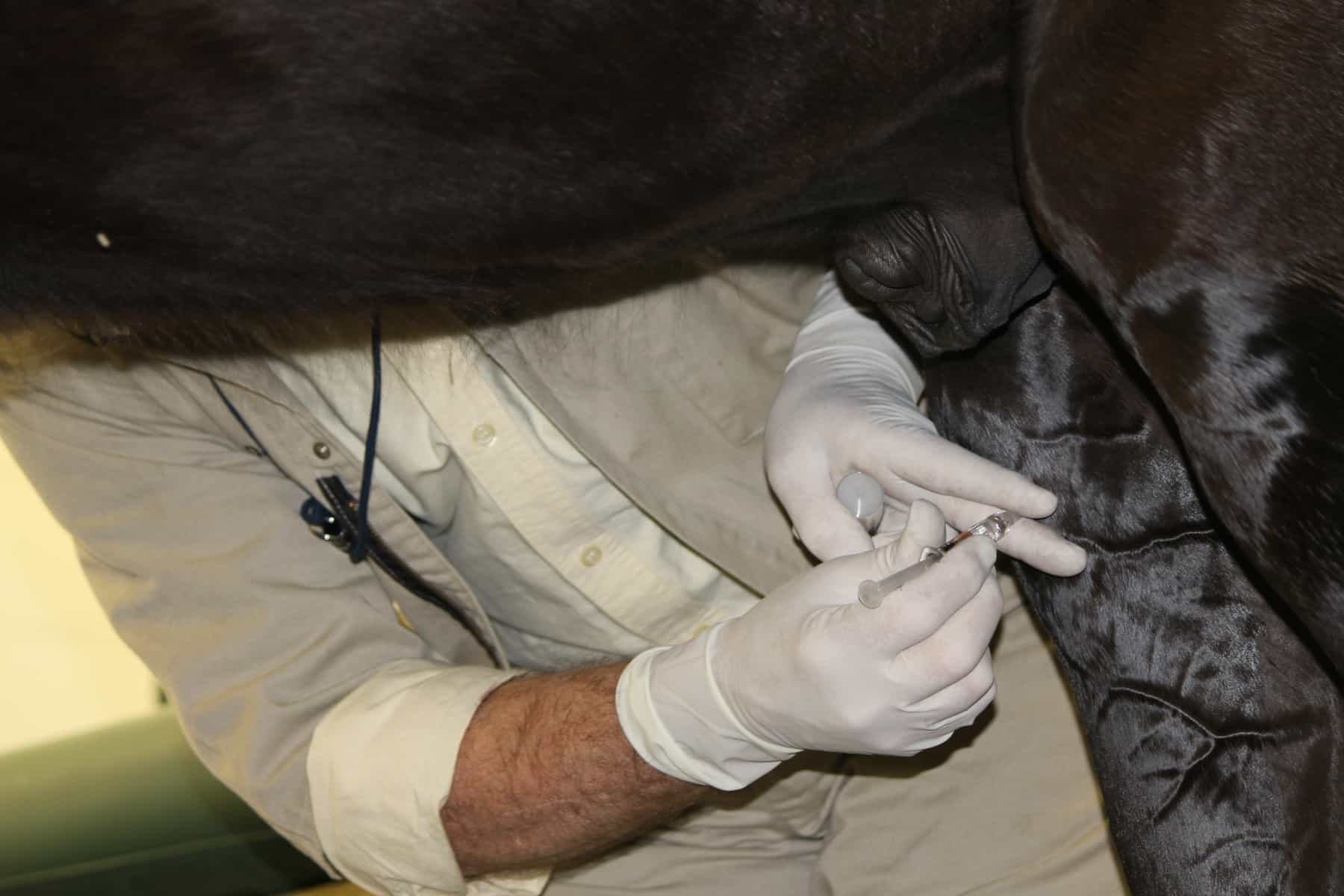Vets Consider Safety, Efficacy of Repeat Corticosteroid Joint Injections in Horses
- Topics: AAEP Convention, Arthritis & Degenerative Joint Disease, Arthritis & Degenerative Joint Disease, Back and Spine, Bone & Joint Problems, Diagnostics and Technology, Horse Care, Lameness, Older Horse Care Concerns, Other Veterinary Technologies, Professional's Guide to Equine Joint Therapies in 2024, Vet and Professional

Veterinarians commonly perform intra-articular injections (IA, or joint injections) in horses to manage the heat, pain/lameness, and swelling associated with osteoarthritis (OA). Despite the extensive and long-standing use of IA corticosteroids for OA treatment, remarkably little research supports this application. The scarce data that have been published show no consistent clinical improvements in horses treated using this method and noted some potentially negative effects on disease progression.
“IA corticosteroids are primarily used for symptomatic improvement/pain relief in joints,” said Paula Tokawa, DVM, of the University of San Paulo’s School of Veterinary Medicine and Animal Science, in Brazil, during her presentation at the 2023 American Association of Equine Practitioners Convention, held Nov. 29-Dec. 3 in San Diego, California. Tokawa presented research on the topic she conducted with Raquel Baccarin, DVM, PhD, of the University of San Paulo and Gustavo Zanotto, DVM, PhD, Dipl. ACVSMR, of Texas A&M University’s College of Veterinary Medicine and Biomedical Sciences, in College Station. “Despite the controversies associated with long-term administration, corticosteroids are still ranked as a main choice among equine veterinarians based on recent surveys.”
Tokawa and her colleagues conducted a systematic review of the literature on the topic with the goal of determining whether injecting corticosteroids IA applied in a frequency of injections lower than three months is detrimental for the clinical and structural progression of OA.
The team reviewed published articles up to June 2022 in which IA corticosteroids were used to treat OA affecting a limb. Only three equine studies met the inclusion criteria, and these studies involved triamcinolone acetonide (TA), methylprednisolone acetate (MPA), and betamethasone (BTM), respectively. In all three studies horses received two injections 14 to 21 days apart and researchers assessed the effects of treatment on patients via lameness examinations, radiographs, synovial (joint) fluid analysis, and microscopic examinations (histology and histochemistry).
The researchers assessed symptom-modifying effects of the corticosteroid on OA (i.e., lameness) and disease-modifying effects on OA (i.e., radiographic and gross findings of joint tissues postmortem, histology and histochemistry via microscopy, and synovial fluid analysis) following treatment.
Due to the small number of cases, the researchers also collected data from six human studies that fit the inclusion criteria. The researchers conducting the human studies did not observe any improvement in lameness in patients treated with MPA and BTM, but they did see improved “patient reported outcome measures” following TA administration; however, these improvements faded with time. For example, in human patients with two-year follow-up data, the researchers noted improvement up to one year but not two years compared to the control group.
“Reasons why TA was losing its effect over time are unclear,” Tokawa said.
In terms of disease-modifying effects, only short-term follow-up data (56 to 72 days) were available in the human studies.
“An improvement in histology and GAG (glycosaminoglycan, an important component of articular cartilage) metabolism was noted for shorter follow-ups; however, studies employing MRI have found loss of cartilage in patients injected with TA in a 2-year period,” Tokawa said.
Take-Home Message
Tokawa noted that the literature is “obviously scarce” but does show there are drawbacks to using frequent, repeat IA injections of corticosteroids. “For TA, some improvements are found short-term, but long-term use has clear drawbacks,” said Tokawa. “Further, there is only limited long-term improvement of symptoms for TA and potential negative effects on cartilage health with all corticosteroids included in this review.”
More research is needed to further explore these findings, but equine veterinarians should be cautious and consider the long-term effects when treating horses with OA using IA corticosteroids.

Written by:
Stacey Oke, DVM, MSc
Related Articles
Stay on top of the most recent Horse Health news with















